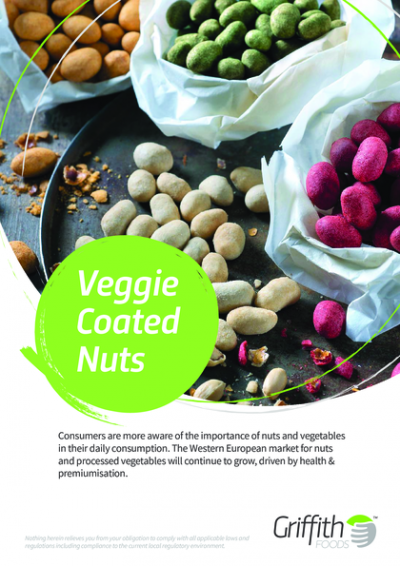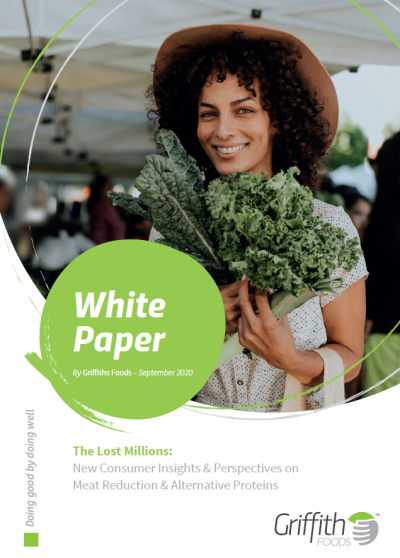Promotional Features
Stepping up to the plate – it’s time for plant-based products to finally deliver
Taste, texture, visual appeal and nutrition – blending these key components in a single bite is an ongoing challenge for the alternative protein market. Can it be done? Yes, say Griffith Foods' experts Alex Skidmore, Market Intelligence Manager, and Jaume Cirera, Market Segment Manager for Alternative Protein, but it calls for a special mix of consumer insights, food science and culinary expertise.
The alternative protein market has come a long way. What’s not working?
Jaume Cirera (JC) The AP category has evolved over recent years, but it hasn’t kept pace with consumer expectations. When you look at the next tranche of consumers entering the category, they already expect it to taste really good, and high-profile launches only heighten consumer expectations. The industry is still trying to fully replicate the taste and texture of meat, and neither is it providing a standalone product worthy of centre plate or as a key component in a meal. Despite numerous launches hitting supermarket shelves, many disappear because they’re falling short on taste, texture, appearance or nutrition – and often all four.
Alex Skidmore (AS) This is really important as the first wave of alternative protein (AP) consumers was fuelled by strong emotional drivers – a desire to save the planet and save animals. This compromised consumer expectations around taste. As AP products have become more mainstream, the consumer demand for taste and texture has increased. So, despite a tonne of investment and all the advances in technology, the level of consumer satisfaction with these products is still low, even though the products have been improving. As an industry, we are continually striving to make improvements to get it right.
Who is the typical Alternative Protein consumer today?
AS We prefer to look at the need states that are driving people into this category. Stand in an AP aisle and you’ll see a diverse range of people. When you consider that 40-50% of consumers claim to be flexitarian, depending which market you’re looking at, this encompasses a multitude of demographics. Essentially, reducing meat consumption, for a multitude of reasons, is driving the category and it’s crucial for us to understand the motivations driving this, not the make-up of the people doing so.
JC Exactly, the sector’s strategy is less about focusing on a demographic, rather an overarching aspiration of catering to all kinds of people who want to reduce their meat consumption. That’s the consumer route into this category and the potential there is huge. If the AP sector can capture 10% of the animal protein market, that would be an incredibly positive place to be – currently, depending on the market, this figure sits between 1-2%.
Is price a pain point for consumers?
AS There’s been no explanation to consumers that the industry doesn’t have the capability to build these products on a mass scale yet, and that investment has been baked into the price. For the majority of consumers who buy plant-based as a replacement for meat, if they have to compromise on taste, they’re definitely not going to compromise on price as well!
JC We have to reach price parity with meat and, particularly now with the cost-of-living crisis, consumers are being more selective with where they’re willing to pay a premium price. To reach mass adoption, the category needs to reach taste and texture parity with meat, as well as overcoming price parity.
How can plant-based innovations meet consumer demands?
AS First, we need to create products that taste good and deliver the desired texture. Our data shows that, on average, only 1 in 8 consumers across Europe have purchased an AP product AND been satisfied with it. This highlights the headroom for improvement in the category. Taste and texture are inherently linked for consumers, and their feedback can be anything from ‘too soft’ to ‘too chewy’, among a variety of other textural complaints. What we get consistently, though, as the main reason that prevents the repeat purchase, is that ‘it’s just not the same as meat’.
JC Understanding this challenge is crucial, and as such we are constantly asking how we can mirror meat texture, or how we can replicate the role that fat or fibrous tissue play in meat.
As a product development partner, our Griffith Foods’ USP comes from leveraging our market knowledge and consumer insights to help our customers align with their customers’ expectations, and because we are a culinary-driven company, our chefs then help our customers optimize their AP products to improve customer satisfaction. Griffith Foods offer solutions for taste, texture, visual appeal and nutrition via our Seasonings, Sauces, Dressings & Marinades, Value-Added Coatings and Functional Blends which we believe can help improve consumer satisfaction, and lead to increased repeat purchase.
We also see the AP category as a catalyst for two of both Griffith Foods and consumers aspirations – food products which are nutritious and sustainable. Whenever possible, our products are designed to meet standards for health and nutrition to deliver the most nourishing product solutions. And on the sustainability front, our sustainable sourcing program, Griffith Sustainably Sourced (GSS), epitomizes this philosophy. Our relationships produce wins for all stakeholders: Griffith Foods receives high quality raw materials from trusted partners; farmers secure higher yields, community assistance, and a consistent buyer; and sustainable agricultural practices also yield environmental benefits.
AS: Our other core competency which we believe adds real value for our customers is our Sensory department. Our professional sensory panel, all of whom have been through an intensive six-month training programme, are invaluable in a category where taste and texture are consistently identified as the main issues, carries out textural and component profiling of products, allowing us to offer genuine objectivity on why a plant-based product tastes good or why it does not.
What specific projects has the sensory panel looked into?
AS We recently conducted an audit in the UK of nearly 300 AP products where we tested them for taste, texture elements and their likeability. We are using this to create a map overlaid with market sales data to help us identify the key themes that lead to higher sales. By understanding the key characteristics of a large range of products, we can identify similarities between products and better understand the preference drivers in the market. Equally, our further sensory capabilities allow us to explore the more technical elements of the products, evaluate new technologies and ingredients, and develop products that are easy for both manufacturers and consumers.
You mentioned that your point of difference is how you leverage consumer and market insights, and the culinary expertise…
JC Yes, by leveraging our in depth, data-driven understanding of local markets and consumer behaviours and preferences, we can focus on the right solutions. Our Food & Flavour Outlook programme combines an analysis of macro- and micro-trends with culinary expertise to create customised solutions. In our Culinary Centres all over Europe, we overlay these trends with a local understanding about what drives consumer preference and enable our customers to make informed decisions around taste and texture that align with their brand and goals. This contributes to the ultimate goal of improving consumer satisfaction.
AS Having chefs around the world means we can help to add authenticity to local cuisines, informed by global trends. As a product development partner, ingredients are just one element of our wider solution approach, and we invite customers to our Culinary Centres to co-create together. It’s here where our chefs and product development colleagues meet with our customers and analyse global culinary trends, and translate them to local market needs. This helps our customers find the right culinary solution for their products, specific to the market they want to tackle. Our newest culinary centre has just opened in Poland and will extend our approach to Eastern Europe markets.
How hands-on is the co-creation process?
JC Our customers co-create with us, from scratch, from ideation sessions through to pilot launches. Everything can be replicated in the pilot industrial kitchen or on a replica of their production lines. Thanks to the ecosystem created with our partners, we can run industrial trials on the machinery that our customers will be working with and they can also test how the end consumer will prepare it at home – this is incredibly valuable.
The co-creation process irons out failures during development and really pays off in the long term. And working side-by side with the chefs, R&D specialists and technicians, means we can respond immediately by matching the right seasonings or texturisers to work in their production lines. It’s a really efficient process and increases speed to market.
How do you forecast future trends for customers?
AS Our many tools allow us to be several steps ahead of the market. Take our Food & Flavour Outlook programme, for example, which provides a trends framework based on the key consumer needs currently combined with a Global understanding of what’s driving our food preferences and food inspirations. We also have the culinary expertise of our chefs, who build a picture of the trends they are seeing and collate them and overlay this expertise so we can better tune our knowledge on both retail and foodservice. We can see what’s emerging from the furthest reaches of Food Service through to even the most ubiquitous and mass market ingredients and flavours in QSR and retail shelves and later this year we’re planning to co-create with our customers using these as our inspiration blocks.
What trends can we expect to see in AP?
JC It’s easy to talk about naturalness, wellness, nutritional goodness and so on, as that’s what’s driving this category. But we believe the segment can also benefit from the trends that are impacting meat, because that’s where this category is aspiring to. Trends incorporating regional-coating styles, signature crunches and nostalgic flavours are definitely worth exploring.
AS Many of the trends around meat are around how ingredients and techniques are used globally, and often how they can be combined to create new complementary or clashing flavours. Techniques such as smoking are really mainstream in meat whereas using multiple ingredients to layer umami levels throughout products are only just emerging and both can be leveraged to great effect in AP products. In terms of flavour, we see a lot of inspiration globally coming out of Mexico and Asia currently, particularly around BBQ and slow cooking influences, with some of the more emerging flavour profiles combining both – Mexican-Korean for example.
We also believe there’s a huge opportunity for value added AP products in the form of differentiated textures and marinades. When you consider the areas of meat that have grown over the last ten years, it’s been added value categories – marinated, coated, ready-to-cook, pre-cooked and sous-vide solutions. AP hasn’t fully embraced these categories yet, but adding a sauce, crumb, seasoning or dressing not only adds colour, it also adds flavour and texture – all of AP’s big needs.
Looking ahead, Griffith Foods aims to be the leading nutritious and sustainable product development partner, helping to drive the sought-after repeat purchase that brands need in order to capitalize on the growth that the AP sector is experiencing. Its potential as a sector is huge.







